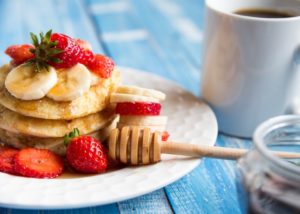Flat out
This pancake batter is soaked to increase nutritional benefits.

Ingredients
Serves approx 8
2 cups buckwheat flour
2 cups buttermilk, milk kefir or yoghurt
2 eggs lightly beaten
1/2 tsp sea salt
1 tsp bi-carb of soda*
2 tsp vanilla essence
2 tblsp melted butter
Coconut oil or butter for frying
*Bi-carb soda is used as a raising agent in these pancakes, as the mixture, after fermenting, is acidic and the reaction between the acid mix and the bi-carb aerates the mixture. In non-acidic mixes, such as ordinary pancakes or cakes, baking powder (which contains cream of tartar) is used to create the reaction needed for aeration.
Method
The traditional way of making pancakes involved soaking the flour in sour or cultured milk, buttermilk or creme fraiche. The acidic nature of these products activates the enzyme phytase which breaks down phytic acid (the mineral binding anti-nutrient in all nuts, seeds, grains and legumes). Sour milk products also contain lactic acid and good bacteria that help to break down complex starches, proteins and irritants. Vitamin content and availability of other nutrients is also increased by soaking. The heaviness and hardness of wholemeal flours is softened by the soaking process, giving you a wonderfully light fluffy result that mimics white flour but with far more nutrition. If you are intolerant to dairy products, you can soak the flour in water with a small amount of whey, yogurt or even vinegar or lemon juice. The results will be not quite as good as a full dairy soak but still much better than no soak at all. Flour is best soaked at least 12 hours at room temperature (not too hot or cold), but even better 24–30 hours, especially in the colder mountain weather. The more freshly ground your flour is, the better the results will be. Soak in a glass, ceramic or pyrex container (plastic is also acceptable but metal is best avoided for fermentation as the acids can react with the metal).
Soak flour in buttermilk, kefir or yoghurt for 12–30 hours. (For a non-dairy/low-dairy alternative, use 2 cups of filtered water plus 2 tblsp whey, lemon juice or vinegar.)
Whisk in other ingredients and thin out with water to desired consistency (a thin batter will give you a more crepe-like pancake, while a thicker batter will make a more pikelet-like pancake).
Cook in a hot cast-iron pan greased with a little coconut oil or butter. Wait till bubbles form on the surface before flipping to cook briefly on the other side.
Serve with your favourite pancake toppings.
Topping ideas: fresh, seasonal fruit, miso and avocado, yoghurt and honey/maple syrup, apple butter and creme fraiche, chai spiced caramel pears, labna, or sweet plum sauce.
Recipe adapted from a Danielle O’Donoghue version.


